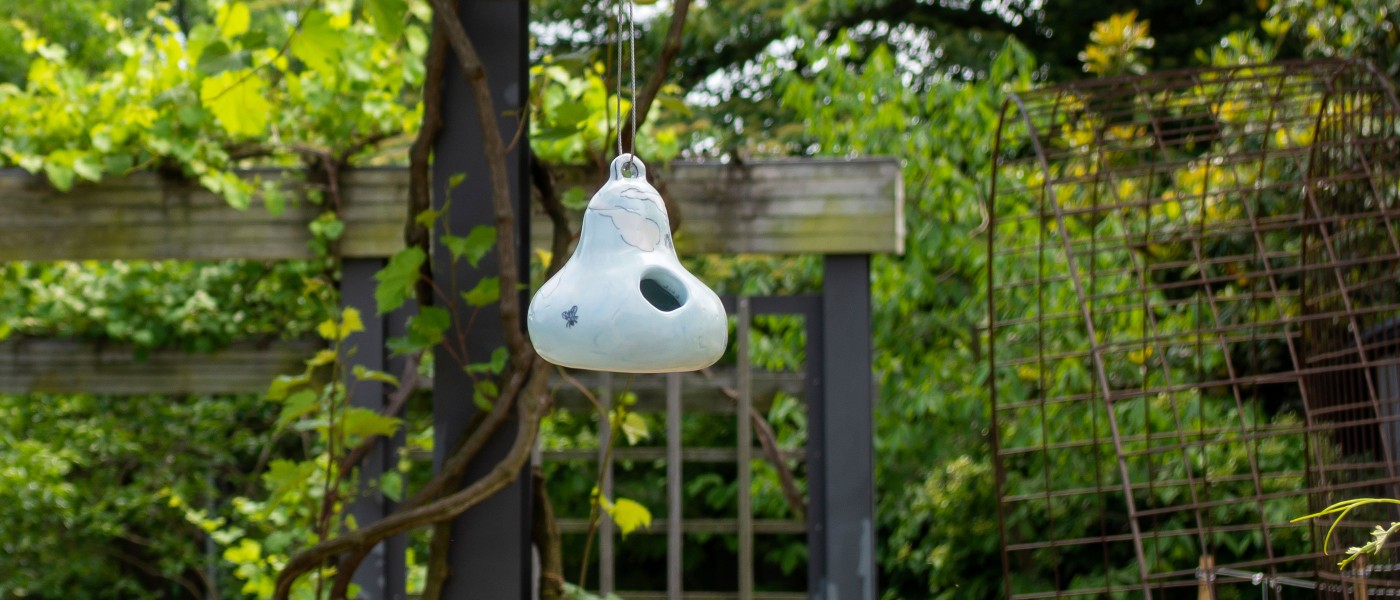The Different Shapes of Home
For artist Viktor Timofeev, the Garden’s For the Birds exhibit was a chance to do something different. The design of his birdhouse, “Jasmuižas 37 - First (bird)house,” located in the Garden’s Annual Border, is a combination of his two childhood homes in Riga, Latvia, in the neighborhoods of Purvciems and Plavnieki.
Observe the structure closely, and you’ll notice that only one of the windows is a hole, and graffiti is scrawled on the walls. “When I added the miniature trees,” Timofeev explains, “I feel like that created a really specific sense of scale that made me feel like I could place myself there.” It’s a playful homage to the houses he grew up in—and a project that touches upon his personal history, which had never been the focus of his art practice.
Brooklyn Botanic Garden has a deep sense of place. That’s due to not only the plant collection, but the wildlife—particularly the birds—that inhabit and have carved out a home and refuge here within the city. The 33 birdhouses in the exhibit serve as both homages to birds and, for some artists, links to their own personal ideas and memories of home.
Artist Kevin Quiles Bonilla remembers how the landscape transformed on the half-hour drive from the dense suburbs of Vega Alta, Puerto Rico, to his grandmother’s house in the fields and meadows of Almirante Sur in Vega Baja. “We would say ‘vamos para al campo,’” Bonilla recalls of that weekly ritual: “We’re going to the fields.”
His birdhouse, Pal’ campo, is a replica of this very house, where every Sunday his family would gather and decompress before the start of the week. A pattern of pebbles encompasses the facade of the birdhouse, taken from a photograph of the terrazzo floors of his grandmother’s home.
Amy Ritter’s birdhouse, Safe Space, was conceived from a place of empathy, and a question: Where is a bird’s home? For Ritter—an artist who focuses on affordable housing and whose work draws upon her own experience growing up in a mobile home community—the answer could be found in nature.
Safe Space, elevated above the human gaze and lushly planted, seems to disappear into the backdrop of the Plant Family Collection, creating what she describes as “home within a home” in the Garden. “It’s a home for all birds,” Ritter says.
Like the migratory birds who might use Safe Space, Ritter considers herself nomadic and transitory. Where she feels most at home is distinct from geography or physical structure. “I can live anywhere,” she says, “as long as I have family or friends and people I enjoy spending time with.”
Germane Barnes—director of Studio Barnes and the 2021–2022 Rome Prize Fellow in Architecture—would agree. For Barnes, whose practice examines how the built environment influences Black domesticity, his approach to architecture is a personal one. He admits that physical structure is his least favorite part of design.
When approaching the design of Fly South, his team asked, How would a bird build things inside of it? Was it large enough to allow multiple birds to be there?
“It’s similar to what we do when we’re designing a kitchen or a front porch,” Barnes explains. “What are the human rituals of this space?” And these rituals are so often tied to the home space. “The home ritual is the one that allows you to be the freest version of yourself,” says Barnes.
It’s not so unlike the house of Bonilla’s grandmother, which to the artist represents a place of warmth, vulnerability, and acceptance. “I always described myself as in a shell before coming to terms with my queerness,” Bonilla explains. But his grandmother’s house was the place he felt the most at ease. “It was the place where I wouldn’t need to hide; I wouldn’t need to sort of be in constant guarding.”
Bonilla hasn’t been back since 2015, when his grandmother passed. But he hopes Pal’ campo serves as a reminder to his family to reactivate the house as a space of gathering. The house has a hold on him, and so does the wider collective sentiment that he feels Puerto Ricans and many others in the diaspora share.
“We hold on to those memories, to those spaces, our grandmother’s houses, our childhood houses.” Bonilla says. “Until that one day, if it comes, we get to go back.”




